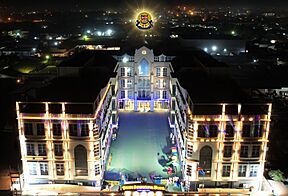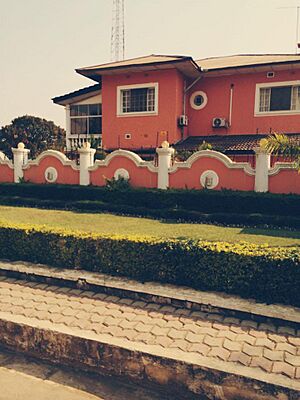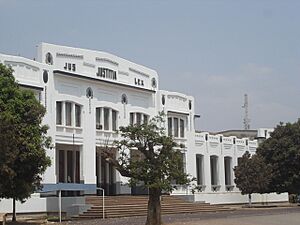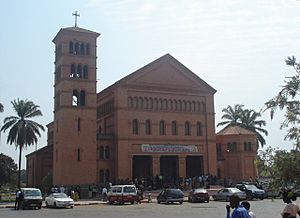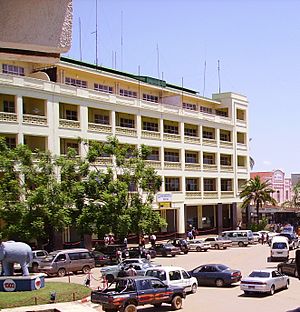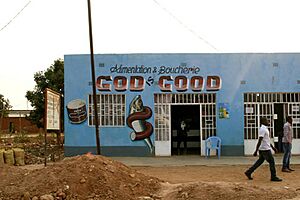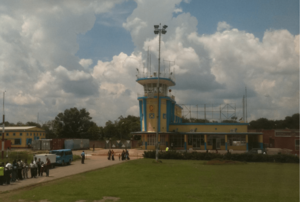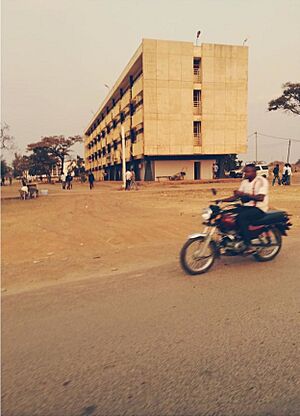Lubumbashi facts for kids
Quick facts for kids
Lubumbashi
|
|||
|---|---|---|---|
|
Provincial capital and city
|
|||
| Ville de Lubumbashi | |||
|
Top: British International School of Lubumbashi bottom left: Streets in urban Lubumbashi. Bottom right: Saints Peter and Paul Cathedral
|
|||
|
|||
| Nickname(s):
L'shi – Lubum
|
|||
| Country | Democratic Republic of the Congo | ||
| Province | Haut-Katanga | ||
| Founded | 1910 | ||
| Area | |||
| • Land | 747 km2 (288 sq mi) | ||
| • Urban | 747 km2 (288 sq mi) | ||
| Elevation | 1,208 m (3,963 ft) | ||
| Population
(2021)
|
|||
| • Urban | 2,584,000 | ||
| • Urban density | 3,459.2/km2 (8,959/sq mi) | ||
| Time zone | UTC+02:00 (Central Africa Time) | ||
| Climate | Cwa | ||
| Website | https://villedelubumbashi.gouv.cd/ | ||
Lubumbashi is the second-largest city in the Democratic Republic of the Congo. It is located in the country's southeastern part, close to the border with Zambia. Lubumbashi is the capital city of the Haut-Katanga Province. It is also a major center for mining, serving as a hub for many large mining companies. In 2021, the city's population was estimated to be around 2,584,000 people.
Contents
A Look at Lubumbashi's Past
How Lubumbashi Began: Élisabethville
The city we know today as Lubumbashi was founded by the Belgian government in 1910. It was first called Élisabethville (or Elisabethstad in Dutch). This name honored Queen Elisabeth, who was married to King Albert I of the Belgians. At that time, the Belgian government had taken control of the area from King Leopold II. They renamed the colony the Belgian Congo.
The location for the city was chosen because it was near the Etoile du Congo copper mine. It was also close to a copper processing plant built by Union Minière du Haut Katanga on the Lubumbashi River. A company called the Comité Spécial du Katanga (CSK) had its main office in Élisabethville. This company had special rights to land and mining in the Katanga province.
Growth and Development
The city grew quickly as the copper mining industry developed. In the 1920s, a lot of money was invested in mining and transportation. New rail lines helped make the Katanga province one of the world's top copper producers. The city's population grew from about 30,000 in 1930 to 180,000 by 1957. It became the second-largest city in the Belgian Congo, after Léopoldville.
During the colonial period, the city center was mainly for the white European population. Most were Belgians, but there were also British, Italian, and Greek Jewish communities. Congolese people were only allowed in the white city during the day. Some house servants lived in small homes behind the European houses.
Many Black residents were workers who moved from other parts of the Belgian Congo or from nearby countries like Belgian Rwanda and Burundi and Northern Rhodesia (now Zambia). They lived in special areas called cité indigène, like Quartier Albert (now Kamalondo). New neighborhoods like Kenia, Katuba, and Ruashi were also created as the population grew. These areas are still important parts of Lubumbashi today. The mining industry made Élisabethville the richest part of the Congo during the last years of Belgian rule.
In December 1941, miners in Élisabethville went on strike. They were protesting the difficult working conditions imposed by the Belgians during the war. A gathering at a football stadium became violent, and police opened fire, leading to many deaths. In 1944, there were more tensions and fears of protests after a military uprising in another city.
In 1957, Élisabethville became an independent city. It held the first free local elections where Congolese people could vote. The people of Élisabethville largely supported the nationalist Alliance des Bakongo party, which wanted immediate independence from Belgium.
Élisabethville was the main city for the Katanga province. It was also a key center for business, industry, education, and health. The Benedictine Order and Order of Salesians provided many schools. The Belgians also founded the University of Élisabethville in 1954–1955, which is now the University of Lubumbashi.
Lubumbashi After 1960
From 1960 to 1963, Élisabethville was the capital of the independent state of Katanga during the Congolese civil war. Moise Tshombe declared Katanga's independence in July 1960. Later, United Nations troops took control of the city in December 1961.
In 1966, Mobutu Sese Seko took power in the Congo and renamed Élisabethville to "Lubumbashi." He also renamed the Katanga province to "Shaba" in 1972.
In May 1990, there was a tragic event at the University of Lubumbashi campus. In 1991–92, tensions between different ethnic groups led to some people being forced to leave the city.
In the late 1990s, Congo faced another civil war. Rebel forces, the Alliance of Democratic Forces for the Liberation of Congo, captured Lubumbashi in April 1997. Their leader, Laurent-Désiré Kabila, announced from Lubumbashi that he was the new president of the Democratic Republic of the Congo on May 17, 1997.
From 1999 to 2003, Lubumbashi served as the legislative capital of the Democratic Republic of the Congo. This meant that the country's parliament met there. Later, all central government offices moved back to Kinshasa.
In 2010, a large prison break happened in Lubumbashi, with 960 prisoners escaping. In 2013, a group of fighters attacked the city and took over a United Nations building.
Where is Lubumbashi?
Lubumbashi is located about 1208 meters (3,963 feet) above sea level. This high altitude helps to keep the climate cooler than it would be otherwise. The Kafue River starts near the city, along the border with Zambia.
What is the Climate Like?
Lubumbashi has a climate with warm, rainy summers and pleasant, dry winters. Most of the rain falls during the summer and early autumn. The average rainfall each year is about 1,238 millimeters (48.75 inches).
| Climate data for Lubumbashi | |||||||||||||
|---|---|---|---|---|---|---|---|---|---|---|---|---|---|
| Month | Jan | Feb | Mar | Apr | May | Jun | Jul | Aug | Sep | Oct | Nov | Dec | Year |
| Mean daily maximum °C (°F) | 26 (79) |
26 (79) |
26 (79) |
27 (81) |
26 (79) |
25 (77) |
25 (77) |
27 (81) |
30 (86) |
31 (88) |
28 (82) |
26 (79) |
27 (81) |
| Daily mean °C (°F) | 21 (70) |
21 (70) |
21 (70) |
20.5 (68.9) |
18 (64) |
16.5 (61.7) |
16.5 (61.7) |
18 (64) |
21 (70) |
23 (73) |
22 (72) |
21 (70) |
20.0 (67.9) |
| Mean daily minimum °C (°F) | 16 (61) |
16 (61) |
16 (61) |
14 (57) |
10 (50) |
8 (46) |
8 (46) |
9 (48) |
12 (54) |
15 (59) |
16 (61) |
16 (61) |
13 (55) |
| Average rainfall mm (inches) | 253 (10.0) |
257 (10.1) |
202 (8.0) |
60 (2.4) |
4 (0.2) |
1 (0.0) |
0 (0) |
0 (0) |
4 (0.2) |
37 (1.5) |
163 (6.4) |
257 (10.1) |
1,238 (48.9) |
| Average rainy days | 24 | 23 | 21 | 9 | 2 | 0 | 0 | 0 | 1 | 5 | 17 | 24 | 126 |
| Source: https://www.weather2travel.com/climate-guides/congo-kinshasa/lubumbashi.php | |||||||||||||
People and Culture
What Languages are Spoken?
French is the official language in Lubumbashi. However, the most commonly spoken language is Kiswahili. The type of Kiswahili spoken in this region is called Kingwana. Many people have moved to Lubumbashi from rural areas for work. They have brought other local languages like Kiluba, Chokwe, Bemba, and Kisanga. Kiswahili is the main language that most people share.
What Religions are Practiced?
Most places of worship in Lubumbashi are Christian. These include the Roman Catholic Archdiocese of Lubumbashi (Catholic Church), the Kimbanguist Church, and various Baptist, Anglican, and Presbyterian churches. In 2020, The Church of Jesus Christ of Latter-day Saints announced plans to build a temple in Lubumbashi. There are also Muslim mosques in the city.
Lubumbashi's Economy
Lubumbashi is an important center for business and industry in the country. Factories here produce textiles, food, drinks, printed materials, bricks, and process copper. The city is also home to the Simba brewery, which makes the famous Tembo beer.
One of the country's largest banks, Trust Merchant Bank, has its main office in Lubumbashi. The city also has a daily newspaper.
Mining in Lubumbashi
Lubumbashi is known as the mining capital of the Democratic Republic of the Congo. It is a key location for many of the country's biggest mining companies. The Democratic Republic of Congo produces a large amount of the world's copper and half of its cobalt. Most of this comes from the Katanga region, where Lubumbashi is located.
Getting Around Lubumbashi
Lubumbashi is a central point for distributing minerals like copper, cobalt, zinc, tin, and coal.
Roads
The city is part of the Transafrican Highway 9 (TAH 9). This road connects Lubumbashi to cities like Lusaka in Zambia and Kolwezi in the Congo.
Railways
Lubumbashi is a hub for railway lines that are part of the Cape to Cairo Railway. These lines connect it to cities such as Ilebo, Kindu, Tenke, Sakania, and Ndola. In Tenke, the city connects to Kolwezi and Lobito via the Benguela railway.
Air Travel
Lubumbashi has a modern airport called Lubumbashi International Airport.
Learning and Education
The largest university in the city is the University of Lubumbashi, which was founded in 1955. There are also other higher education institutions like the Protestant University of Lubumbashi.
For younger students, there are international schools such as the Belgian international school (École Privée Belge de Lubumbashi) and the French international school (Établissement scolaire français Blaise-Pascal).
City Life and Fun
Parks to Explore
Muyambo Kyasa helped make parks popular in Lubumbashi. Muyambo Park opened in 2010. It's about 15 km from the city and is a large garden where kids can play and adults can relax. Other parks or farms nearby include Mikembo and Futuka (which used to be a wildlife reserve).
The Lubumbashi Zoo
The Lubumbashi Zoo is one of the most popular places to visit. It was created a long time ago during the colonial period. Although it faced challenges during wartime, it has been restored by a group called AZLU. By 2007, many new animals had been brought to the zoo. AZLU manages the zoo for education and to protect the country's natural wildlife. Today, you can see lions, tigers, monkeys, pelicans, crocodiles, snakes, and many other animals. The zoo also has a restaurant, a vet center, and a termite museum.
Arts and Entertainment
Art in the City
While Kinshasa is very famous for its art, Lubumbashi also has talented artists. Some well-known painters from the region include Pilipili, Mwenze, Angali, and Tshimbumba.
Movies and Cinema
Ciné Bétamax (formerly "Ciné Palace" and "Ciné Eden") are the main modern movie theaters in the city. They usually show popular movies from Hollywood. They also show films about Congolese and African history. Before the main movie, they often play Congolese and international music videos. The University of Lubumbashi sometimes works with the movie theater to show student films. Ciné Bétamax also screens big football matches and hosts concerts and Christian meetings.
Nollywood films from Nigeria are also very popular in Lubumbashi, just like in many other parts of Africa. These movies are often sold on VCD and DVD.
Music Scene
Popular music from Kinshasa is very much enjoyed in Lubumbashi. Jean-Bosco Mwenda is probably the most famous musician from Katanga. Many of his songs are classics and are often remixed by new artists. Modern singers in Lubumbashi often play Soukous music or international urban music. Many artists are influenced by successful producers like Dj Spilulu and singers from Kinshasa.
Lubumbashi music often uses many languages in its lyrics, including Swahili, Lingala, Tshiluba, French, and some English. This mix of languages shows the diverse nature of the city.
French Cultural Influence
The "Institut Français" (also known as "Centre Culturel Français") is in the center of the city. It plays a big role in Lubumbashi's cultural life. Students and researchers use its library. It shows European and French-language films, puts on plays, and sells local singers' music.
Radio Okapi's Role
Radio Okapi's presenters in Lubumbashi have a cultural program called "métissage" every Saturday evening. This program helps inform the whole country about cultural events happening in the city.
News and Media
National TV and Radio
RTNC (Congolese National Radio and Television) has a local station in Lubumbashi. It was very important from the 1960s until the mid-1990s, before the rise of modern technology.
Independent Channels
Zenith Radio was the first independent radio station in the city, starting in 1996. Since then, many other radio and television stations have been created. These include religious channels, commercial channels, and mixed channels.
Famous People from Lubumbashi
- Bismack Biyombo (born 1992), NBA basketball player
- Grady Diangana (born 1998), Footballer
- Oscar Tshiebwe (born 1999), Basketball player for the Kentucky Wildcats men's basketball team
- Lous and the Yakuza (born 1996), singer, rapper, and model
- Tshala Muana (1958–2022), singer and dancer
- Baloji (rapper) (born 1978), hip hop artist and actor
- Robert Kidiaba (born 1976), Politician and former professional footballer
Sports in Lubumbashi
Football (Soccer)
Football is the most popular sport in Lubumbashi. The city is home to top national football clubs like FC Saint Eloi Lupopo, CS Don Bosco, and TP Mazembe. TP Mazembe is the most successful club in the country. They have won Africa's Champions League 5 times and reached a FIFA Club World Cup final. The chairman of TP Mazembe is Moïse Katumbi Chapwe, who used to be the governor of Katanga province.
Before 1960, football in Congo was separated into leagues for white players and leagues for black players. In 1911, the white-only Ligue de Football du Katanga was founded in Elisabethville. In 1950, the black-only Elisabethville Football Association had over 30 clubs. Both types of tournaments were played until 1960, when they were combined. Since then, the traditionally black clubs have been very successful.
The city's football tournament is now called the Ligue de Football du Lubumbashi. FC Saint-Eloi Lupopo has won this league 25 times.
Basketball
Basketball players Myck Kabongo and Bismack Biyombo are from Lubumbashi. Oscar Tshiebwe, who was named the best men's college basketball player in 2022, is also from Lubumbashi.
Sister City
 Liège, Belgium
Liège, Belgium
Images for kids
See also
 In Spanish: Lubumbashi para niños
In Spanish: Lubumbashi para niños


